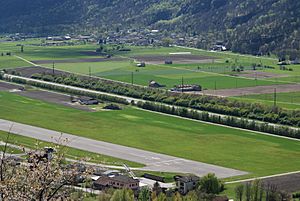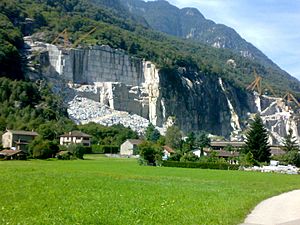Lodrino, Ticino facts for kids
Quick facts for kids
Lodrino
|
||
|---|---|---|

Lodrino village center
|
||
|
||
| Country | Switzerland | |
| Canton | Ticino | |
| District | Riviera | |
| Area | ||
| • Total | 31.5 km2 (12.2 sq mi) | |
| Elevation | 269 m (883 ft) | |
| Population
(December 2004)
|
||
| • Total | 1,556 | |
| • Density | 49.40/km2 (127.94/sq mi) | |
| Postal code |
6527
|
|
| Surrounded by | Biasca, Cresciano, Iragna, Lavertezzo, Moleno, Osogna, Preonzo | |
Lodrino was a small town, also known as a municipality, located in the Riviera district of the canton of Ticino in Switzerland. It sat on the right bank of the Ticino river.
On April 2, 2017, Lodrino joined with three other towns: Cresciano, Iragna, and Osogna. Together, they formed a brand new municipality called Riviera.
Contents
History of Lodrino
Lodrino is a very old place. It was first mentioned in historical records way back in 857, known then as Ludrini. Later, in 1193, it was called Ludrino.
Archaeologists have found signs of old forts here. These suggest that a noble family, possibly from Lombardy (a region in Italy), lived in Lodrino during the 12th and 13th centuries. This time period is known as the Middle Ages.
During the Middle Ages, Lodrino also included a small village called Prosito. Prosito was likely as important as Lodrino and Iragna until the mid-1400s. There were also communities living on the mountainside, known as Monte Parli.
Old Churches and Local Power
The church of SS Gervasio e Protasio in Prosito was built in the 13th century. It might have been a private church. Another important church was the Chapel of San Martino di Monte Paglio, built in 1215. It served the mountain villages.
The main church in Lodrino was St. Ambrogio. It was first mentioned in 1375 and built on the remains of an even older church from the 11th or 12th century. These churches were supported by the local religious leader, called a Vicar, from a nearby town named Biasca.
In 1441, the Duke of Milan gave some land to Uri, a part of Switzerland. This led to changes in how the Riviera region was governed. Lodrino, Prosito, and Iragna were given a lot of freedom to choose their own local leaders and make their own laws. They had special rules called "village statutes" in 1450 and 1492. In 1496, these towns officially pledged their loyalty to the Swiss Confederation, which was the early form of Switzerland.
Work and Development in Lodrino
For many centuries, people in Lodrino made a living from farming and raising animals. Later, between 1782 and 1869, there was a glass factory and a small fabric-making industry.
When the Gotthard railway was being built, many granite quarries opened in Lodrino. These quarries dug out stone for the railway. Some quarries are still working today, even though fewer people work there now.
In 1939, a fortified line called the Lona-line was built. It was about 10 kilometers (6 miles) long and had 23 anti-tank forts to protect the area. Since 1943, a small military airfield, the Lodrino Air Base, has been in use. Today, it's also used for civilian helicopters.
In recent decades, Lodrino saw a lot of new buildings. Many new homes, schools, and sports facilities were built, showing the town was growing.
Geography of Lodrino
Lodrino covered an area of about 31.5 square kilometers (12.2 square miles). A small part of this land, about 7.9%, was used for farming. A large part, about 68.3%, was covered by forests.
About 3.6% of the land had buildings or roads. Rivers and lakes made up about 1.9% of the area. The remaining 17.2% was unproductive land, meaning it couldn't be used for farming or building.
Most of the forests were dense, with some areas having smaller trees or orchards. The farming land was used for growing crops and for alpine pastures where animals grazed. All the water in Lodrino was from flowing rivers and streams. The unproductive areas were either covered in plants that weren't useful or were too rocky.
Coat of Arms of Lodrino
The coat of arms for Lodrino has a green background. On it, you can see a silver chisel and a golden hammer crossed over each other. These tools represent the stone quarries that were very important for jobs in the town.
At the top of the shield, there's a red cloak over a silver sword with a golden handle. The cloak and sword are symbols of St. Martin, who is the patron saint of the village church. At the bottom, there's a golden bell.
People of Lodrino (Demographics)
In 2008, about 27.1% of the people living in Lodrino were from other countries. Over ten years, from 1997 to 2007, the number of people living in Lodrino grew by about 12.9%.
Most people in Lodrino speak Italian language. In 2000, about 88.4% of the population spoke Italian. The second most common language was Portuguese, spoken by 4.8% of residents. Serbo-Croatian was third, spoken by 2.5%. A small number of people also spoke French or Romansh.
In 2008, the population was almost evenly split between males (51.4%) and females (48.6%). Most residents were Swiss citizens, but a good number were non-Swiss.
Many people living in Lodrino in 2000 were born there (41.3%). Others were born in the same canton (20.9%) or elsewhere in Switzerland (5.8%). About 29.4% of the population was born outside of Switzerland.
The age groups in Lodrino in 2009 showed a mix of ages. About 10.5% were children aged 0-9, and 11.3% were teenagers aged 10-19. Adults aged 20-59 made up a large portion of the population. There were also many older adults, with 12.2% aged 60-69, 8.8% aged 70-79, and 3.5% over 80.
In 2000, there were 549 households in Lodrino, with an average of 2.6 people per household. Many households were single-person homes, but there were also many married couples, with and without children.
The historical population of Lodrino has changed over time, as shown in the chart below:

Economy of Lodrino
In 2007, the unemployment rate in Lodrino was about 3.89%. This means a small percentage of people who wanted to work couldn't find jobs.
The economy of Lodrino involved different types of work:
- Primary sector: This includes jobs that get raw materials from nature, like farming. In 2005, about 28 people worked in this area.
- Secondary sector: This involves making things, like in factories or construction. About 291 people worked in this sector, including manufacturing, mining (from quarries), and construction.
- Tertiary sector: This includes jobs that provide services, like shops, transportation, hotels, education, and healthcare. About 344 people worked in this sector.
In 2008, there were 604 full-time jobs in Lodrino. A significant number of jobs were in manufacturing, mining (quarries), and construction. Many people also worked in professional and scientific fields, education, and healthcare.
Many people who lived in Lodrino traveled to other towns for work (412 workers). Fewer people traveled into Lodrino for work (325 workers). This means more people left Lodrino to work than came in. Most people (65.3%) used a private car to get to work, while a smaller number (6.6%) used public transportation.
Religion in Lodrino
According to the 2000 census, most people in Lodrino were Roman Catholic, making up about 86.4% of the population. A smaller number, about 1.4%, belonged to the Swiss Reformed Church.
Other Christian groups, like Orthodox churches, also had members. There were also a few people who were Islamic or Buddhist. About 4.31% of the population did not belong to any church or religion.
Education in Lodrino
Many people in Lodrino have a good education. About 35.4% of the population had completed upper secondary education, which is like high school. About 5.9% had gone on to higher education, like a university or a specialized college.
In 2009, there were 289 students in Lodrino. The education system in Ticino canton offers different levels of schooling:
- Kindergarten: This is for young children and is not mandatory. In Lodrino, 47 children were in kindergarten.
- Primary School: This program lasts for five years. There were 94 students in standard primary schools and 4 in special schools.
- Lower Secondary School: After primary school, students go to middle school. Some attend a two-year middle school followed by a pre-apprenticeship, while others go to a four-year program to prepare for higher education.
- Upper Secondary School: This level prepares students for a trade or for university. Students can attend vocational schools while doing an internship or apprenticeship.
- Professional Program: This three-year program prepares students for jobs in fields like engineering, nursing, or computer science.
In 2000, 129 students came to Lodrino from other towns to attend school. At the same time, 36 residents of Lodrino went to schools outside the municipality.
See also
 In Spanish: Lodrino (Suiza) para niños
In Spanish: Lodrino (Suiza) para niños







